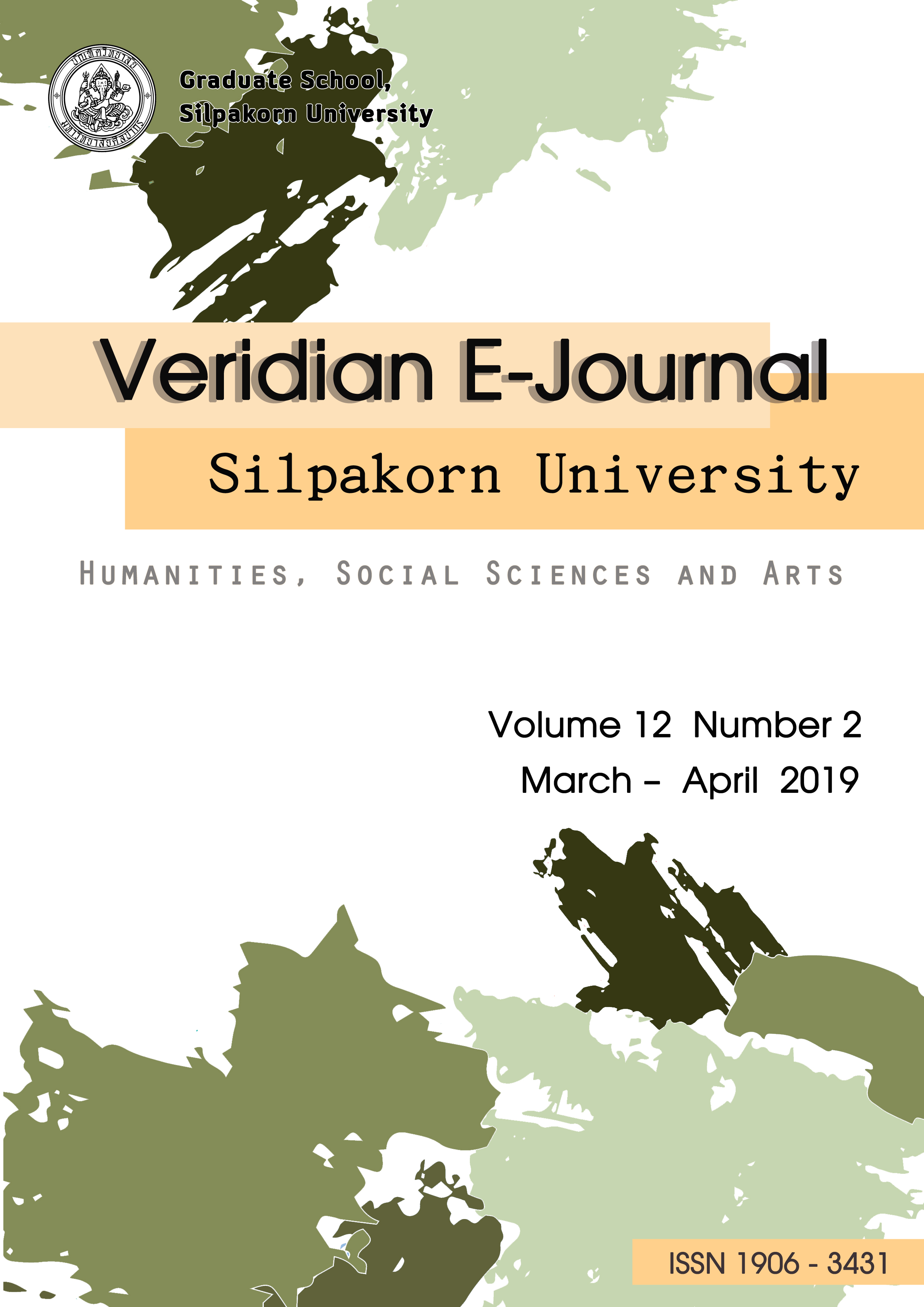ความเข้าใจเรื่องความฉลาดรู้ทางอาหารของนิสิตครูคหกรรมศาสตร์ (Food Literacy Understanding of Pre-service Home Economics Teachers)
Main Article Content
Abstract
การวิจัยนี้มีวัตถุประสงค์เพื่อศึกษาความเข้าใจเรื่องความฉลาดรู้ทางอาหารของนิสิตครูคหกรรมศาสตร์ ผู้มีส่วนร่วมในการวิจัย คือ นิสิตครูชั้นปีที่ 1-5 จากหลักสูตรคหกรรมศาสตรศึกษาแห่งหนึ่ง ในปีการศึกษา 2560 จำนวน 68 คน เครื่องมือที่ใช้ในการวิจัย คือ แบบสอบถามความเข้าใจเรื่องความฉลาดรู้ทางอาหาร และแนวทางสัมภาษณ์เพิ่มเติม วิเคราะห์ข้อมูลโดยการวิเคราะห์เนื้อหา ดำเนินการวิจัยโดยสอบถามความเข้าใจเรื่องความฉลาดรู้ทางอาหารก่อน และจัดกิจกรรมขยายความเข้าใจเรื่องความฉลาดรู้ทางอาหารโดยใช้สื่อ แล้วสอบถามความเข้าใจเรื่องความฉลาดรู้ทางอาหารอีกครั้ง ส่วนนิสิตฝึกประสบการณ์วิชาชีพศึกษาศาสตร์ปี 5 เก็บข้อมูลโดยไปรษณีย์อิเล็กทรอนิกส์ ผลการวิจัย พบว่า เมื่อถามความเข้าใจเรื่องความฉลาดรู้ทางอาหาร ผู้มีส่วนร่วมในการวิจัยทุกคนมีความเข้าใจเกี่ยวกับความฉลาดรู้ทางอาหารว่าเป็นความเข้าใจเรื่องอาหาร เช่น โภชนาการ สารอาหาร สุขาภิบาลอาหาร เป็นต้น ซึ่งเป็นเพียงส่วนหนึ่งของความฉลาดรู้ทางอาหาร หลังจากจัดกิจกรรมแล้วสอบถามเพิ่มเติม พบว่า นิสิตครูคหกรรมศาสตร์ เข้าใจความฉลาดรู้ทางอาหารกว้างขึ้นกว่าเดิม ซึ่งผู้วิจัยนำข้อมูลมาแบ่งกลุ่มสาระสำคัญของความฉลาดรู้ทางอาหารตามความเข้าใจของนิสิตครูคหกรรมศาสตร์ เป็น 4 ด้าน ได้แก่ ความรู้ ความตระหนัก การปฏิบัติ และมิติอื่น ๆ ที่เกี่ยวข้องกับอาหาร
The purpose of this research was to study food literacy understanding of pre-service and in-service home economics teachers. The participants were 68 students of a home economics education program in academic year 2017. The research instrument was the Food Literacy Understanding Questionnaire and Guideline for Interview. Content analysis was used for data analysis. The food literacy questionnaire was implemented with pre-service teachers before and after using food literacy understanding media. However, the food literacy questionnaire was implemented with the fifth year pre-service teachers without using the media. The results showed that all participants understood that food literacy was fundamental understanding on food for instance nutrition, nutrients, and food sanitation. This understanding is only parts of food literacy. Besides, they had added four domains of food literacy included knowledge, awareness, practice and other dimensions involved food.
Article Details
References
มานิตา ลีโทชวลิต อรรถนุพรรณ. (2561). ปลูกและเติบโต: การทำงานสวนสำหรับเด็กปฐมวัย. Veridian E-Journal, Silpakorn University 11, 3 (กันยายน – ธันวาคม 2561), 177-191.
2. Food for Change Project. (2018). Retrieved February 25, 2018 from https://www.food4change.in.th.
โครงการกินเปลี่ยนโลก. (2561). เข้าถึงวันที่ 25 กุมภาพันธ์ 2561 จาก https://www.food4change.in.th.
3. Institute for Population and Social Research, Mahidol University. (2018). “yokyō̜ng Thai prathēt chan nam kǣ rōk mai tittō̜ rư̄arang” in sukkhaphāp Khon Thai 2018 phut sātsanā kap kānsāng sœ̄m suk phāwa (NCDs) [Praising Thailand, the leading country to solve chronic non-communicable diseases]. Nakhon Pathom: Institute for Population and Social Research, Mahidol University.
สถาบันวิจัยประชากรและสังคม มหาวิทยาลัยมหิดล. (2561). ยกย่องไทยประเทศชั้นนำแก้โรคไม่ติดต่อเรื้อรัง (NCDs). ใน สุขภาพคนไทย 2561 พุทธศาสนากับการสร้างเสริมสุขภาวะ. นครปฐม: สถาบันวิจัยประชากรและสังคม มหาวิทยาลัยมหิดล.
4. Sampran model. (2018). Retrieved March 22, 2018 from https://sampranmodel.com.
สามพรานโมเดล. (2561). เข้าถึงวันที่ 22 มีนาคม 2561 จาก https://sampranmodel.com.
5. Sustainable Agriculture Foundation (Thailand). (2018). Retrieved February 25, 2018 from https://www.sathai.org.
มูลนิธิเกษตรกรรมยั่งยืน (ประเทศไทย). (2561). เข้าถึงวันที่ 25 กุมภาพันธ์ 2561 จาก https://www.sathai.org.
6. Thailand Pesticide Alert Network: Thai-PAN. (2018). Retrieved February 20, 2018 from https://thaipan.org.
เครือข่ายเตือนภัยสารเคมีกำจัดศัตรูพืช. (2561). เข้าถึงวันที่ 20 กุมภาพันธ์ 2561 จาก https://thaipan.org.
7. The National Food Committee. (2010). krō̜p yutthasāt kānčhatkān dān ʻāhān khō̜ng prathēt Thai [Strategic Framework for Food Management in Thailand]. Retrieved July 10, 2017 from https://newsser.fda.moph.go.th/TNFC/ download.php?up_id=35.
คณะกรรมการอาหารแห่งชาติ. (2553). กรอบยุทธศาสตร์การจัดการด้านอาหารของประเทศไทย เข้าถึงวันที่ 10 กรกฎาคม 2560 จาก https://newsser.fda.moph.go.th/TNFC/download.php?up_id=35.
8. Yingyuad, N., Tanpichai, P., Srisuantang, S., Kerdsap, T. (2018). kānphatthanā kitčhakam kān rīanrū thāng kasēt læ singwǣtlō̜m nai rōngrīan phān kānmī sūanrūam khō̜ng phākhī khrư̄akhāi : kō̜ranī sưksā kitčhakam phūm that kin dai rōngrīan wat sālī čhangwat Suphan burī [The Development of Agricultural and Environmental Learning Activity through the Participation of Network and Partnership: A Case Study Edible Garden in Wat Sali School, Suphanburi Province]. Veridian E-Journal, Silpakorn University 11, 1 (January – April 2018), 578-596.
นิรันดร์ ยิ่งยวด, ประสงค์ ตันพิชัย, สันติ ศรีสวนแตง, ธัญลักษณ์ เกิดทรัพย์. (2561). การพัฒนากิจกรรมการเรียนรู้ทางเกษตรและสิ่งแวดล้อมในโรงเรียนผ่านการมีส่วนร่วมของภาคีเครือข่าย: กรณีศึกษา กิจกรรมภูมิทัศน์กินได้ โรงเรียนวัดสาลี จ.สุพรรณบุรี. Veridian E-Journal, Silpakorn University 11, 1 (มกราคม – เมษายน 2561), 578-596.
ภาษาอังกฤษ
9. Beauman, C., Leitzmann, C., Shetty, P. et al. (2005). The Giessen Declaration. Public Health Nutrition. September 2005; 8(6A): 783-786.
10. Benn, J. (2014). Food, nutrition or cooking literacy – a review of concept and competencies regarding food education. International Journal of Home Economics 7(1), 13-35.
11. Colatruglio, S. & Slater, J. (2014). Chapter 3: Food Literacy: Bridging the Gap between Food, Nutrition and Well-Being. In Deer, F., Falkenberg, T., McMillan, B. & Sims, L. (Eds.), Sustainable well-being: concepts, issues, and educational practices (pp. 37-55). Manitoba, Canada: Education for Sustainable Well-Being Press (ESWB Press).
12. Dyg, P. M. (2014). Fostering food literacy and food citizenship through farm-school cooperation and beyond: theoretical perspectives and case studies on farm-school cooperation and food and agriculture education. Institut for Planlægning, Aalborg Universitet, Denmark.
13. Fullan, G. (2014). Food Literacy is about More Than Labels and Recipes. Retrieved May 20, 2017, Website: https://www.alternativesjournal.ca/community/blogs/mouthful/food-literacy-about-more-labels-and-recipes.
14. German, K. (2015). Schoolyard Farmers: Youth Writing Food Literacy Curriculum. Master of Arts Graduate Department of Curriculum, Teaching and Learning, University of Toronto.
15. Nakayama, S., Ito, Y., Kawamura, M., Fujita, T. & Nishihara, N. (2017). A text book for Home Economics Professional Learning Program. Chiba: Kaishin Ltd.
16. Nerman, D. (2015). Food education the law in Japan. Retrieved May 18, 2017, Website: https://www.cbc.ca/news/health/food-education-the-law-in-japan-1.2894279.
17. Nourish. (2009). Nourish Curriculum Guide. Retrieved July 15, 2017, from
https://www.nourishlife.org/teach.
18. Nowak, A. J., Schneyer, L. and Roberts, K. H. (2012). Building Food Literacy and Positive Relationships with Healthy Food in Children through School Gardens. Childhood Obesity: 8(4): 392-395.
19. Palumbo, R. (2015). Sustainability of well-being through literacy. The effects of food literacy on sustainability of well-being. Agriculture and Agricultural Science Procedia 8(2016) 99- 106.
20. Pendergast, D., Garvis, S., and Kanasa, H. (2011). Insight from the Public on Home Economics and Formal Food literacy. Family & Consumer Science Research Journal 39(4), 415-430.
21. Pendergast, D., and Dewhurst, Y. (2012). Home economics and food literacy – An International investigation. Retrieved April 20, 2017, https://www98. griffith.edu.au/ dspace/bitstream/handle/10072/49542/79938_1.pdf?sequence=1.
22. Ronto, R., Ball, L., Pendagast, D., and Harris, N. (2016). Adolescents’ perspectives on food literacy and its impact on their dietary behaviours. Appetite 107(2016): 549-557.
23. Stinson, E. (2010). Eating the World: Food Literacy and Its Place in Secondary School Classrooms. Master of Education in the Department of Curriculum and Instruction, University of Victoria.
24. The Center for Ecoliteracy. (2017). A New Era for Nutrition Education. Retrieved May 20, 2017, from Center for ecoliteracy Website: https://www.ecoliteracy.org/essays/new-era-nutrition-education.
25. The Edible Schoolyard Project. Retrieved July 13, 2017, Website: https://edibleschoolyard.org.
26. Vidgen, H. A. (2014). Food Literacy: What is it and does it influence what we eat? Doctor of Philosophy School of Exercise and Nutrition Sciences, Faculty of Health, Queensland University of Technology. Retrieved March 13, 2017, Website: https://eprints.qut.edu.au/66720/1/Helen_Vidgen_Thesis. pdf.
27. Winslow, D. (2012). Food for Thought: Sustainability, Community-Engaged Teaching and Research, and Critical Food Literacy. Doctor of Philosophy in Composition and Cultural Rhetoric in the Graduate School of Syracuse University.
